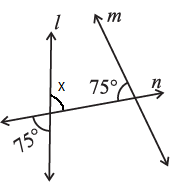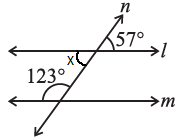(i) Let us consider the two lines, l and m.
n is the transversal line intersecting l and m.
We know that the sum of interior angles on the same side of the transversal is 180o.
Then,
= 126o + 44o
= 170o
But, the sum of interior angles on the same side of transversal is not equal to 180o.
So, line l is not parallel to line m.
(ii) Let us assume ∠x be the vertically opposite angle formed due to the intersection of the straight line l and transversal n,
Then, ∠x = 75o

Let us consider the two lines, l and m.
n is the transversal line intersecting l and m.
We know that the sum of interior angles on the same side of the transversal is 180o.
Then,
= 75o + 75o
= 150o
But, the sum of interior angles on the same side of transversal is not equal to 180o.
So, line l is not parallel to line m.
(iii) Let us assume ∠x be the vertically opposite angle formed due to the intersection of the Straight line l and transversal line n.

Let us consider the two lines, l and m.
n is the transversal line intersecting l and m.
We know that the sum of interior angles on the same side of the transversal is 180o.
Then,
= 123o + ∠x
= 123o + 57o
= 180o
∴ The sum of interior angles on the same side of the transversal is equal to 180o.
So, line l is parallel to line m.
(iv) Let us assume ∠x be the angle formed due to the intersection of the Straight line l and transversal line n.

We know that the Linear pair is the sum of adjacent angles equal to 180o.
= ∠x + 98o = 180o
= ∠x = 180o – 98o
= ∠x = 82o
Now, we consider ∠x and 72o are the corresponding angles.
For l and m to be parallel to each other, corresponding angles should be equal.
But, in the given figure, corresponding angles measure 82o and 72o, respectively.
∴ Line l is not parallel to line m.













